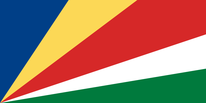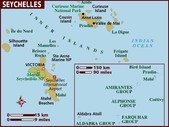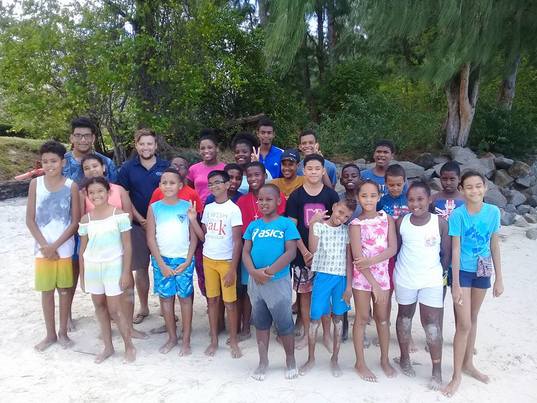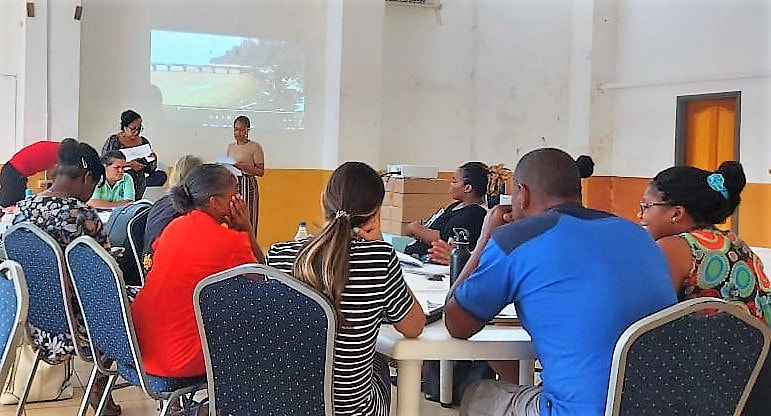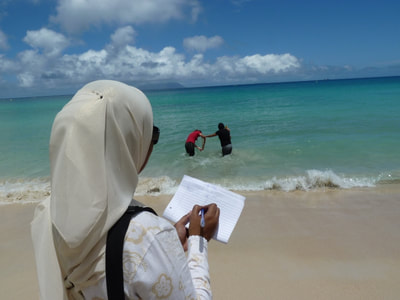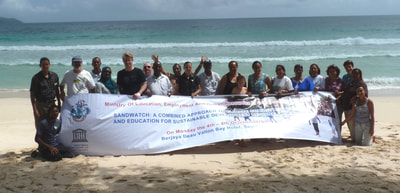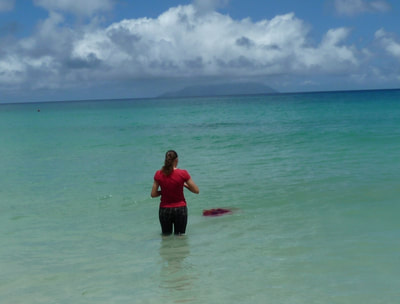Seychelles
Sandwatch activities started in: 2003
Coordination of Sandwatch in Seychelles:
Sandwatch in Seychelles has been coordinated by the Ministry of the Environment, Energy and Climate Change with the help of the Ministry of Education, the UNESCO National Commission for the Seychelles and schools throughout the country.
Status of Sandwatch in Seychelles: Active
Activities and Highlights: Updates in progress
August 29, 2018: Sandwatch Programme field trip to the west coast, Anse Boileau Beach has been chosen for our monitoring programme.
|
Forty Seychelles Sandwatchers take part in online Beach Records training
May 2023: The Seychelles, on 12th May an online Beach Records training session was held with 40 teachers in Seychelles as part of the Seychelles Ministry of the Environment’s planned activities in the regional RECOS (Coastal Ecosystems Resilience in the Southwest Indian Ocean) project. Please contact the Sandwatch Foundation if you would like to hear more about the online Beach Records platform and/or schedule an online introduction or training session. |
Greetings to all Sandwatchers
Anse Kerlan beach, on the island of Praslin in Seychelles, has been for a long time under the attack of wave erosion, especially during the South-East Monsoon. Following the December tsunami in 2004 the situation has worsened, so much so that some of the Praslin Secondary School teachers living in that area decided to move out since they felt that now more than ever they were at the mercy of the mighty sea.
The Small Islands Voice Youth Group, being a group, which is eager to discover new things, and who want to contribute to the development of our community, put what we learnt at school in practice, and decided to carry out a mini-project in this area. The aim of the project was to collect information to assess the effect and rate of erosion. We did this at three sites along the area of study.
The tsunami has helped to change the gradient and shape of the beach and to make what were once grass-covered yards in front of the houses in the vicinity, areas completely covered by great depth of sand.
We collected as much information as possible about our beach. Based on our conclusions we recommended to the Ministry of Environment and Marine Resources that (1) they carry out a more detailed study; (2) the Small Islands Voice Youth continue their study; (3) more trees be planted to hold the sand; and (4) that the present system of groynes should be modified and that underwater
stabilisers be constructed. (Underwater stabilisers are geotextile tubes, filled with concrete or sand, and placed underwater perpendicular to the shoreline. They are designed to help to reduce wave energy and turbulence, thus making the area calmer).
By Ms.Anabelle Hoareau, Praslin Secondary School, Seychelles
Anse Kerlan beach, on the island of Praslin in Seychelles, has been for a long time under the attack of wave erosion, especially during the South-East Monsoon. Following the December tsunami in 2004 the situation has worsened, so much so that some of the Praslin Secondary School teachers living in that area decided to move out since they felt that now more than ever they were at the mercy of the mighty sea.
The Small Islands Voice Youth Group, being a group, which is eager to discover new things, and who want to contribute to the development of our community, put what we learnt at school in practice, and decided to carry out a mini-project in this area. The aim of the project was to collect information to assess the effect and rate of erosion. We did this at three sites along the area of study.
The tsunami has helped to change the gradient and shape of the beach and to make what were once grass-covered yards in front of the houses in the vicinity, areas completely covered by great depth of sand.
We collected as much information as possible about our beach. Based on our conclusions we recommended to the Ministry of Environment and Marine Resources that (1) they carry out a more detailed study; (2) the Small Islands Voice Youth continue their study; (3) more trees be planted to hold the sand; and (4) that the present system of groynes should be modified and that underwater
stabilisers be constructed. (Underwater stabilisers are geotextile tubes, filled with concrete or sand, and placed underwater perpendicular to the shoreline. They are designed to help to reduce wave energy and turbulence, thus making the area calmer).
By Ms.Anabelle Hoareau, Praslin Secondary School, Seychelles
Feburary 2012, the S3A2 Sandwatchers of English River School conduct a study on the severe erosion affecting North-East Point Beach, Praslin Island.
- click here to read their full report
- click here to read their full report
Seychelles Sandwatchers (English River School) participated in the Clean up the world at North East Point Beach in September 2010
The North East Point beach is situated to the North East of the Mahe Island. North East Point is a residential area as well as a recreational area. The home of the elderly and a rehabilitation centre are also found close to the beach. The beach is often used for picnics and other recreational activities.
The location has been chosen since the club has adopted the beach to carry out different SandWatch activities since 2008. Furthermore, since the theme is ‘communities caring for nature’ we wanted to move to the community to show our concern for a cleaner beach. Some students also live in the area; we therefore wanted to instill a sense of ‘caring’ for their beaches and their environment.
The Sandwatchers cleaned up a large area of the beach. Some students from the primary school and people from the community were also actively involved. The Sandwatchers parents provided some refreshment for the students. We are grateful to the Waste Management department at the Ministry of Environment especially, Ms Nada Francourt who provided the equipment, transportation and lunch for the Sandwatchers. The students also carried out a pollution survey at the beach. The findings showed that pollution is a major concern at the North East Point beach. Plastic bottle, plastic bags and glass bottles were the largest amount of litter found. The main source is by the picnickers. We feel that smaller bins are needed along the beach and more education needs to be done regarding the dangers of litter for the coastal environment.
By Ms Wendy Noel, English River SandWatch Coordinator, Seychelles
The North East Point beach is situated to the North East of the Mahe Island. North East Point is a residential area as well as a recreational area. The home of the elderly and a rehabilitation centre are also found close to the beach. The beach is often used for picnics and other recreational activities.
The location has been chosen since the club has adopted the beach to carry out different SandWatch activities since 2008. Furthermore, since the theme is ‘communities caring for nature’ we wanted to move to the community to show our concern for a cleaner beach. Some students also live in the area; we therefore wanted to instill a sense of ‘caring’ for their beaches and their environment.
The Sandwatchers cleaned up a large area of the beach. Some students from the primary school and people from the community were also actively involved. The Sandwatchers parents provided some refreshment for the students. We are grateful to the Waste Management department at the Ministry of Environment especially, Ms Nada Francourt who provided the equipment, transportation and lunch for the Sandwatchers. The students also carried out a pollution survey at the beach. The findings showed that pollution is a major concern at the North East Point beach. Plastic bottle, plastic bags and glass bottles were the largest amount of litter found. The main source is by the picnickers. We feel that smaller bins are needed along the beach and more education needs to be done regarding the dangers of litter for the coastal environment.
By Ms Wendy Noel, English River SandWatch Coordinator, Seychelles
Indian Ocean Regional Sandwatch Workshop scheduled to be held in Seychelles 4-8 October 2010
View full details, amazing photos and a video from the Oct 2010 Sandwatch Workshop!
In 2009 the Sandwatch approach was expanded to include climate change resilience building,, with the support of the Government of Denmark, UNESCO and the Sandwatch Foundation. The Sandwatch manual was revised and trialed at a Sandwatch workshop in The Bahamas in June 2009. The manual has now been published and will be launched at an Indian Ocean Regional Workshop to be held in Seychelles 4-8 October 2010. The workshop will bring together several new and experienced Sandwatch practitioners. In addition, work has progressed on developing a Sandwatch database that will provide a scientific tool and record of the beach monitoring activities being conducted by Sandwatch groups worldwide. The prototype database will be presented and discussed at the workshop.
The Indian Ocean Regional Sandwatch Workshop is being held in Seychelles with the support of UNESCO and the Seychelles Ministry of Education, Employment and Human Resource Development. The objectives of the workshop are:
1. To launch Sandwatch in the Indian Ocean region, especially in Comoros, Rodrigues, Mauritius and Maldives
2. To re-invigorate Sandwatch in Seychelles and enhance the skills of existing Sandwatch practitioners in Seychelles
3. To form a group of Sandwatch trainers, skilled in the revised Sandwatch approach that incorporates climate change adaptation and resilience building, and equipped to spread the revised approach nationally and in the Caribbean and Pacific regions
4. To trial the prototype Sandwatch database
Representatives from the Comoros, Maldives, Mauritius, Seychelles, Fiji, Cook Islands and The Dominican Republic will be present at the workshop as well as experts and guest speakers from Canada, Australia, France and St. Kitts & Nevis
View full details, amazing photos and a video from the Oct 2010 Sandwatch Workshop!
In 2009 the Sandwatch approach was expanded to include climate change resilience building,, with the support of the Government of Denmark, UNESCO and the Sandwatch Foundation. The Sandwatch manual was revised and trialed at a Sandwatch workshop in The Bahamas in June 2009. The manual has now been published and will be launched at an Indian Ocean Regional Workshop to be held in Seychelles 4-8 October 2010. The workshop will bring together several new and experienced Sandwatch practitioners. In addition, work has progressed on developing a Sandwatch database that will provide a scientific tool and record of the beach monitoring activities being conducted by Sandwatch groups worldwide. The prototype database will be presented and discussed at the workshop.
The Indian Ocean Regional Sandwatch Workshop is being held in Seychelles with the support of UNESCO and the Seychelles Ministry of Education, Employment and Human Resource Development. The objectives of the workshop are:
1. To launch Sandwatch in the Indian Ocean region, especially in Comoros, Rodrigues, Mauritius and Maldives
2. To re-invigorate Sandwatch in Seychelles and enhance the skills of existing Sandwatch practitioners in Seychelles
3. To form a group of Sandwatch trainers, skilled in the revised Sandwatch approach that incorporates climate change adaptation and resilience building, and equipped to spread the revised approach nationally and in the Caribbean and Pacific regions
4. To trial the prototype Sandwatch database
Representatives from the Comoros, Maldives, Mauritius, Seychelles, Fiji, Cook Islands and The Dominican Republic will be present at the workshop as well as experts and guest speakers from Canada, Australia, France and St. Kitts & Nevis
Activities
Aug 2018, Sandwatch Programme field trip to the west coast, Anse Boileau Beach has been chosen for our monitoring programme.
Feb 2012, The S3A2 Sandwatchers of English River School conduct a study on the severe erosion affecting North-East Point Beach, Praslin Island.
Sept 2010, The English River School Sandwatcher conduct a beach clean up and write and article for the Sept `10 issue of The Sandwatcher
October 2010, The Seychelles hosts a regional Indian Ocean Sandwatch Workshop for representatives from all over the region and world
June 2008, Sandwatch Club of English River School win prize for an international video competition on effects of Climate Change, click here for full details.
May 2008, Seychelles Ministry of Education publishes a story on "Local Sandwatch Experience" in their newsletter
January 2008, Seychelles Ministry of Education publishes their Environmental Education Newsletter detailing many of their environmental projects
November 2007, staff and students write articles and poems on the threat posed to their islands by climate change in the Nov '07 Sandwatcher
June 2007, the Seychelles Dept of the Environment conduct new Sandwatch workshops, details of which are published in the June '07 Issue of The Sandwatcher
May 2007, The Sandwatch Project is expanded to include eight (8) more schools! Read the report in The Seychelles Nation newspaper (in PDF format 65kb)
December 2006, An article on Beach Erosion is published in the 2nd Issue of The Sandwatcher
June 2006, Article on their environment and Sandwatch activities published in inaugural issue of The Sandwatcher newsletter
In 2005, following the Indian Ocean tsunami, the Small Islands Voice Youth at the Praslin Secondary School, conducted a Sandwatch study of the Anse Kerlan beach where erosion had worsened since the tsunami – read their report
In 2004 Sandwatch training workshops were held in Anse Royale and Anse Boileau Secondary Schools in Mahe.
In 2003, Ms. Jeanette Larue of the Ministry of Education and Youth participated in the second Sandwatch Workshop in Dominica in 2003.
Aug 2018, Sandwatch Programme field trip to the west coast, Anse Boileau Beach has been chosen for our monitoring programme.
Feb 2012, The S3A2 Sandwatchers of English River School conduct a study on the severe erosion affecting North-East Point Beach, Praslin Island.
Sept 2010, The English River School Sandwatcher conduct a beach clean up and write and article for the Sept `10 issue of The Sandwatcher
October 2010, The Seychelles hosts a regional Indian Ocean Sandwatch Workshop for representatives from all over the region and world
June 2008, Sandwatch Club of English River School win prize for an international video competition on effects of Climate Change, click here for full details.
May 2008, Seychelles Ministry of Education publishes a story on "Local Sandwatch Experience" in their newsletter
January 2008, Seychelles Ministry of Education publishes their Environmental Education Newsletter detailing many of their environmental projects
November 2007, staff and students write articles and poems on the threat posed to their islands by climate change in the Nov '07 Sandwatcher
June 2007, the Seychelles Dept of the Environment conduct new Sandwatch workshops, details of which are published in the June '07 Issue of The Sandwatcher
May 2007, The Sandwatch Project is expanded to include eight (8) more schools! Read the report in The Seychelles Nation newspaper (in PDF format 65kb)
December 2006, An article on Beach Erosion is published in the 2nd Issue of The Sandwatcher
June 2006, Article on their environment and Sandwatch activities published in inaugural issue of The Sandwatcher newsletter
In 2005, following the Indian Ocean tsunami, the Small Islands Voice Youth at the Praslin Secondary School, conducted a Sandwatch study of the Anse Kerlan beach where erosion had worsened since the tsunami – read their report
In 2004 Sandwatch training workshops were held in Anse Royale and Anse Boileau Secondary Schools in Mahe.
In 2003, Ms. Jeanette Larue of the Ministry of Education and Youth participated in the second Sandwatch Workshop in Dominica in 2003.
